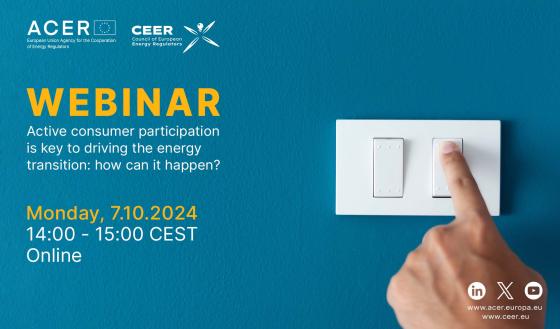of household electricity consumers
are on fixed and inflexible contracts
Active consumer participation is key to driving the energy transition – how can it happen?
2024 Market Monitoring Report
The EU’s drive towards carbon neutrality by 2050 requires swift changes. The ACER-CEER 2024 Market Monitoring Report on energy retail and consumer protection emphasises that the clean energy transition will not occur without power system flexibility and the active participation of energy consumers.
What are the key recommendations of the energy regulators’ report?
- Retail markets can play a pivotal role as providers of flexibility. Unlocking more flexible retail consumption is crucial for the energy transition's success. It also creates opportunities for consumers to benefit from lower energy prices.
- The report calls on regulatory authorities and Member States to prioritise demand-side response frameworks, incentivise efficient grid use, and accelerate the rollout of smart meters. Dynamic pricing and flexible contracts are key to empowering consumers.
What key challenges did the report identify?
The report highlights key trends in the retail electricity and gas markets in 2023:
- Smart meter rollout remains slow: Smart meters are critical for giving consumers real-time control over their energy use and savings. However, in 10 Member States fewer than 30% of households have access to them, with 6 of those having a rollout below 10%.
- Increased price volatility: The frequency of low and negative wholesale electricity prices surged 12-fold in 2023 compared to 2022. This volatility shows the growing need for system flexibility. Daily flexibility needs will more than double by 2030.
- Fixed contracts dominate: 73% of EU households are on regulated fixed or market-based fixed electricity contracts. To empower consumers, more flexible, market-based contract options need to be offered.
- Price interventions hinder flexibility: In 8 Member States, untargeted price interventions have slowed the adoption of flexible pricing contracts and consumption practices, which are crucial to meeting both consumers and grid needs.
How to unlock retail flexibility?
Barriers to demand response must be dismantled and supportive investment frameworks created to enable small, climate-compatible flexibility resources to participate in all electricity markets on an equal footing with traditional centralised sources of flexibility.
Unlocking flexibility in the retail energy markets will require efforts across several fronts:
- Update the regulatory framework: Promote demand-side response, while balancing household consumer protection in the lead-up to 2030.
- Incentivise efficient grid use: Regulators should incentivise Distribution System Operators (DSOs) to optimise grid efficiency, ensuring that infrastructure investment supports future energy needs.
- Accelerate smart meter rollout: The slow rollout of smart meters remains a barrier. Member States, regulators, and DSOs need to speed up the rollout of smart meters. Regulators and suppliers must ensure consumers are offered a wider range of flexible contracts, including dynamic price contracts.
- Empower and inform consumers: Member States, regulators and suppliers must raise consumer awareness of the benefits of flexible energy use (such as potential cost savings and reduced carbon footprints) and provide incentives that reflect these benefits.
Active consumer participation is key to driving the energy transition – how can it happen?

Highlights
-
73%
-
8
Member States continuing with untargeted price interventions impeding flexibility
-
12-fold
increase in low and negative wholesale electricity prices signalling the need for more flexibility
Report
The EU’s drive towards carbon neutrality by 2050 requires swift changes. This report emphasises that the clean energy transition will not occur without power system flexibility and the active participation of energy consumers.
Country Sheets
For the first time, ACER publishes its Country Sheets to present key metrics on retail electricity markets across EU Member States and Norway. These short 1-pagers provide insights into:
-
key market facts;
-
consumer trends, including contract uptake and bill breakdown;
-
national progress towards 2030’s decarbonisation targets, showing status of electric vehicles’ uptake (EVs), EV’s charging stations, the installation of heat pumps and the share of final renewable energy consumption;
-
a high-level SWOT analysis to show strengths, weaknesses, opportunities and threats of each market.
Infographic
Interested in the main highlights of the report?
Dashboard
ACER's monitoring shows a gradual decrease in EU household energy prices
This ACER data dashboard tracks the monthly changes in electricity and gas prices, including components like energy, network charges, and taxes across Member States and EEA (Norway) from January 2019 to August 2024.
ACER monitoring shows:
- Average EU energy prices stabilised in 2024 after a major decrease the previous year, although they are still higher than pre-crisis.
- Retail price variations depend on contract types. Member States with more fixed-rate contracts saw slower reductions, leading to higher consumer costs compared to those with dynamic contracts.
The assessment relies on data collected by Vassa ETT consultancy and covers data from January 2019 to August 2024.
Webinar
ACER and CEER will hold a webinar to present the main findings and recommendations of this report.
When?
Monday, 7 October 2024 at 14:00 CEST
Additional information
- Access the underlying datasets
- See the corrigendum of 4 October 2024 to Figure 1

